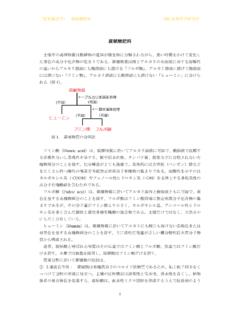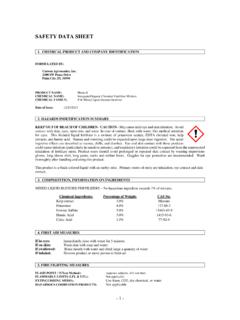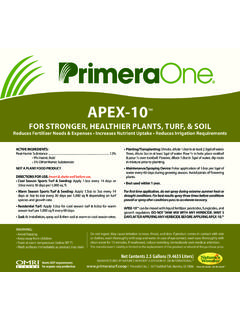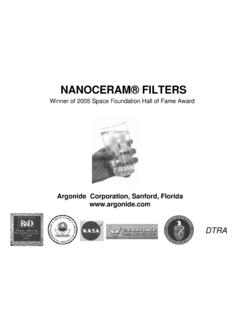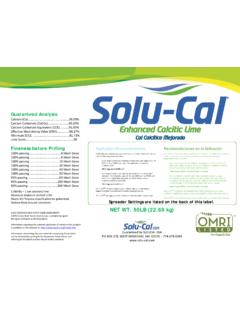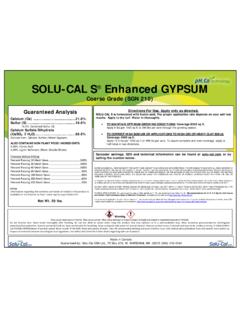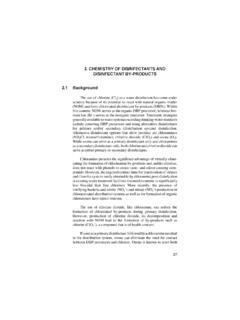Transcription of Chelates - What are they and What do they do? By …
1 Chelates - what are they and what do they do? By Erik Biksa The word chelate (pronounced: key-late ) comes from the Greek word chele which literally means claw . The word chelate was first used by researchers in the 1920s because it describes the principal of grasping and holding something, which is essentially what occurs in the process of chelation. Growers who primarily focus on Nitrogen, Phosphorous, and Potassium often overlook the importance of other elements. Trace nutrients are described as being necessary for plant growth, although in small quantities.
2 Without the use of Chelates many of these nutrients would be unavailable to plants. In fact, many of the minerals we ingest in our diets are chelated. It's pretty safe to say that our existence is somewhat dependent on principles of chelation. Here is a basic example of the role Chelates play in making nutrients available to plants: Many trace elements in their basic form(s) are unavailable to plants. This is largely due to the fact that these metals, such as iron, are positively charged. The pores (openings) on the plants' leaves and roots are negatively charged.
3 As a result, there is a problem with the fixation of positively charged minerals at the negatively charged pores (the element can't enter the plant due to the difference in charges). However, if a chelate is added with an element like iron it effectively encapsulates (surrounds) the metal/mineral ion and changes the charge into a negative or neutral charge, allowing the element to enter the pore and travel into the plant. Some chelating agents may only have the ability to partially surround an element and should be referred to as a complexes , while those that completely surround the mineral are true Chelates .
4 Now, if you pick up your container of fertilizer and have a look at the label you should see EDTA beside some of the trace elements. If you also see DTPA you are using a more complex fertilizer. If you see EDDHA beside iron, you are using a very high quality fertilizer. There are a couple of other synthetic Chelates , but are not commonly used so will not be discussed. If you use an organic fertilizer, don't worry we'll get to that. Ethylenediaminetetraacetate (EDTA) is the most common chelating agent found in synthetic fertilizers. Like other synthetic Chelates , EDTA is an alien compound to the plant and is therefore not absorbed by the plant.
5 When the chelated element (remember it's encapsulated) is required, the plant will remove the element, for example iron, form the chelate and absorb the element. However, since the chelating agent is foreign to the plant, it will give up the chelating agent (EDTA) back into solution where it is free to chelate other positively charged elements. EDTA has four points of connection to the elements it Chelates . Different Chelates have varying numbers of points of connection. In some situations four points of connection may hold the element too tightly, where in other growing situations, it may not hold it tight enough.
6 For example, EDTA is better suited to slightly lower than neutral pH levels. Iron often becomes deficient at higher pH. values such as those typically associated with rockwool or mineral soils. Diethylenetriaminepentaacetate (DTPA) is a chelating agent better suited to high pH levels. As the chemical name suggests, it has five (penta, ie. Pentagram) points of connection to the element it Chelates . DTPA is more costly than EDTA and is less soluble so it is found in smaller quantities than EDTA in most synthetic fertilizer formulations. Several studies suggest that ethylenediaminedihydroxy-phenylaceticaci d (EDDHA) is that superior synthetic chelating agent.
7 Its relatively high cost prohibits it from being added to many synthetic fertilizer formulations. In a recent study conducted by the Research Station for Floriculture and Glasshouse Vegetables (Netherlands) it was demonstrated that plants perform better, even under adverse conditions when the primary source of iron is chelated by EDDHA. In the experiment, chrysanthemums were grown aeroponically, and a portion of the plants were inoculated (infected) with a root disease (pythium). Only four percent of the plants infected with pythium demonstrated chlorosis (yellowing of leaves associated with iron deficiency) when supplied with EDDHA.
8 In comparison, 35% of the plants supplied with DTPA became chlorotic, and 18% of the plants supplied with HEDTA demonstrated chlorosis. W W W. G CHYDRO. COM | I NFO@G C H Y D R O .C O M | IS-NUT-0413. COPYRIGHT GCH,INC. 2016 PAGE 1. As a result, the dry weights of plants supplied with EDDHA were significantly higher in both infected and uninfected plants. An additional benefit found in tissue analysis showed that the plants supplied with EDDHA were able to absorb 2X the levels of zinc than the plants supplied with HEDTA and DTPA. This is significant to our purposes because zinc (and iron) is often locked out in the later part of flowering due to excessive phosphorous levels.
9 Ever notice how yellow plants can get as harvest approaches? , so now we have an idea how Chelates work, and that not all synthetic Chelates are equal in their abilities to supply nutrients to the plant. But, how do these nutrients enter the plant in nature, where EDTA, DTPA and EDDHA are not present in the soil? Fulvic acid is a biological chelating agent. It results from the decomposition of organic matter into humus, which is microbially processed into humic acids, microbe's further process the humic acids to produce fulvic acid. Fulvic acids are lighter in weight and more biologically active than their precursor, humic acids.
10 Weighing between 7,000 to 70,000. Daltons, fulvic acids are very light when compared to their humic counterparts weighing up 700,000 Daltons. they are also much more biologically active. In simplest terms, humic acids are associated with the physical characteristics of soil, and fulvic acids are associated more closely with the plants biochemical reactions influencing the plants metabolism. It's a question of feeding the soil or feeding the plant. Fulvic acid forms a four-point bond with the elements it Chelates . One of the greatest advantages in adding a biological chelate such as high quality fulvic acid to your nutrient solution is that unlike the synthetic Chelates likely present in your nutrients, the fulvic acid chain can be absorbed into the plant.

